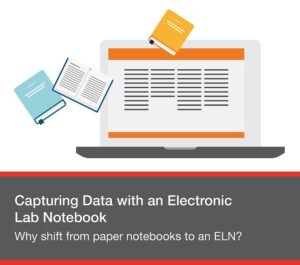Why shift from paper notebooks to an ELN?
 Deciding to move from paper notebooks to an Electronic Lab Notebook is a big step for an organization. It’s a big step toward increasing productivity and sharing with colleagues, and a big step toward protecting the IP of your experiments. This sounds like a lot, but an ELN is so much more than a digital replacement for a lab notebook. It is the first step of your research process, and an active partner in your work, allowing you to search experimental data across your organization. ELNs have not been a “trending topic” online lately, so we thought we would provide a quick reminder of the capabilities of the present-day ELN.
Deciding to move from paper notebooks to an Electronic Lab Notebook is a big step for an organization. It’s a big step toward increasing productivity and sharing with colleagues, and a big step toward protecting the IP of your experiments. This sounds like a lot, but an ELN is so much more than a digital replacement for a lab notebook. It is the first step of your research process, and an active partner in your work, allowing you to search experimental data across your organization. ELNs have not been a “trending topic” online lately, so we thought we would provide a quick reminder of the capabilities of the present-day ELN.
Benefits of an ELN
An ELN is a safer way to hold your data. Paper can be lost (or locked in a desk), spilled upon, or physically destroyed in other ways. An ELN is digitally backed-up and can only be accessed by users with the correct permissions. For a cloud- or web-based ELN, information is accessible for users around the world.
Capturing your data is the essence of an ELN. Users can enter content manually and the ELN should be able to access data from instruments, and other connected systems. An ELN should be easy to integrate with data capture devices, instruments, and other enterprise applications. Not only does an ELN capture your data, but it ensures you will never have a problem with difficult to read or smudged writing.
Standardizing data capture with an ELN
An open page of a paper notebook is an invitation for creativity, even in a structured lab environment. Every researcher or lab may have a separate way of recording data for experiments. This variety makes it difficult to maintain data quality, completeness, and compliance with business rules. With an Electronic Lab Notebook, labs can use templates to ensure all notebook entries are built the same way. Templates can also be used to speed data entry by storing default data that is commonly filled out for many notebook entries. Standardization of data capture helps you to enforce processes in your lab and reduce risk.
A lab is no place for scrapbooking. It can happen as researchers attempt to include relevant data, by printing, cutting and attaching charts, tables, and pictures to pages in notebooks. An ELN should allow you to integrate documents and digital images for quick access and traceability. Access to chemistry drawing tools in an electronic lab notebook enables more accurate representations of chemical reactions and allows users to search structures, record and track experiments, execute stoichiometry calculations, register molecules, and more.
Searching and sharing lab notebook data
Paper notebooks are very difficult to share, and unless you’re at the same lab bench, they are impossible to share in real time. A cloud- and web-based ELN can be private or shared across a lab or multiple collaborative partners. Sharing encourages consistency within the lab and reduces research silos and prevents duplicate experiments. Sharing your data is important for working within an organization and for working with outside collaborators.
Searching in a paper notebook means leafing through pages (ouch, paper cuts), and it is very difficult to find connections between experiments or components of the experiment without manually compiling data. Fully functional searching in an ELN enables users to find new connections and insights. Linking data between an ELN and a LIMS is immensely beneficial for an organization. For example, tracking the linkage of products and reagents used in synthesis along with the instruments that were used enable end-to-end visibility across your experiments, reduce risk from data re-entry or manual errors by leveraging existing data, and can be used to help identify sources of error and improve processes. An ELN should reduce boundaries, by making research within the organization searchable across experiments, projects, and workflows.
ELN data security and protection
Paper notebooks can be, well, an open book. Unless they are under lock and key, there is no way to protect the intellectual property hidden within the pages. An ELN is protected by the security measures established by your organization as well as the multiple levels of security involved in cloud-hosting options (if you go that route). Reports in an ELN can be closed, signed and witnessed. If changes must be made, a new version is saved with a time and date stamp before another signature—keeping the trail of documents and creating appropriate audit trails.
Labguru ELN Software
Labguru ELN software provides capabilities for designing, storing, organizing, and reporting on your research. It enables users to easily create new notebooks and entries, record experimental data, find and edit existing entries, and witness and sign entries and notebooks. With the Labguru ELN, organizations and scientists can seamlessly share data and results with colleagues and external collaborators on any connected device in a secure, 100% web- and cloud-based environment.
Leave a Reply